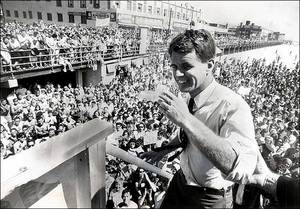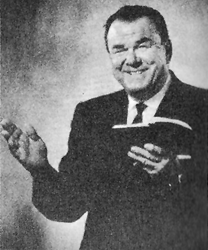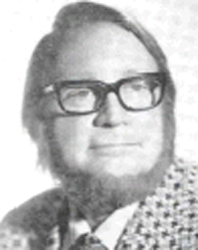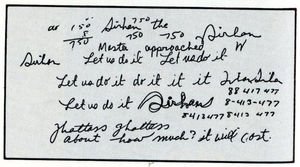
|
| ©Unknown |
From the Carl Bernstein article 'CIA and the Media', published in Rolling Stone on October 20, 1977,
"One of the things we always had going for us in terms of enticing reporters," observed a CIA official who coordinated some of the arrangements with journalists, "was that we could make them look better with their home offices. A foreign correspondent with ties to the Company [the CIA] stood a much better chance than his competitors of getting the good stories."This is what the concept of "embedded reporters" was all about. The program was an offshoot of a CIA program which used reporters as agents, a secret project begun in the late 1940's called Operation Mockingbird, but with a twist. This program would be carried out in the open. Rather than secretly recruiting key reporters from mass media outlets, virtually every reporter allowed access - nearly 800 of them, by some reports - to the "inside story" of the war would be carefully controlled by military and intelligence agencies. Not only would these reporters look good by getting the "inside" story, they would be bound to show only what the military and intelligence communities would allow for fear of losing their position.
The rabbit hole goes deeper and deeper. The infiltration of the CIA, recruiting agents and operatives to work covertly for them, touches virtually every aspect of society. An idea like that might be hard to get your head around, but it is in fact well documented. Some have even been surprisingly frank about their association with the CIA. For example, in an editorial for National Review on November 1, 2005, William F. Buckley wrote:
When, in 1951, I was inducted into the CIA as a deep cover agent, the procedures for disguising my affiliation and my work were unsmilingly comprehensive. It was three months before I was formally permitted to inform my wife what the real reason was for going to Mexico City to live. If, a year later, I had been apprehended, dosed with sodium pentothal, and forced to give out the names of everyone I knew in the CIA, I could have come up with exactly one name, that of my immediate boss (E. Howard Hunt, as it happened). In the passage of time one can indulge in idle talk on spook life. In 1980 I found myself seated next to the former president of Mexico at a ski-area restaurant. What, he asked amiably, had I done when I lived in Mexico? "I tried to undermine your regime, Mr. President." He thought this amusing, and that is all that it was, under the aspect of the heavens.It is easy to dismiss someone like Chuck Barris and his Confessions of a Dangerous Mind as mere delusions of a deranged mind (which is possibly the point of the book/movie), but not so with someone of Buckley's stature.
Buckley's admitted boss, E. Howard Hunt (allegedly the spy for whom Tom Cruise's character in Mission: Impossible, Ethan Hunt, is named) shortly before his death implicated David Atlee Phillips in the assassination of JFK, chronicled in an April 5, 2007 Rolling Stone article. He wrote out the cast of characters for his son, Saint John Hunt, putting Lyndon Johnson at the top of the list. David Atlee Phillips worked closely with another CIA operative by the name of David Sanchez Morales. Bradley Ayers, a retired US army captain who had worked closely with Morales, identified him in film footage taken at the Ambassador Hotel the night RFK was shot, along with two other known CIA agents. One has to wonder just what someone like Morales, a CIA agent with close ties to agents strongly suspected of taking part in political assassinations, would have been doing there that night?
The rabbit hole goes deeper still. As one explores the depth and breadth of CIA involvement in every aspect of culture, one is left with the unnerving feeling that the CIA almost literally defines every aspect of culture. That, in fact, seems to be their goal.
The best known CIA mind control operation, which involved the well documented torture of hundreds of adults, most notably the patients at Allan Memorial Institute in Canada by Dr. Ewen Cameron, was called MKULTRA. By the time the program was discovered and investigated by Congress, it had allegedly been terminated without positive results. That, at least, is what was claimed by the CIA. What else were they expected to say? What they did to the unwilling participants in MKULTRA was unconscionable and revolting. They were physically tortured, given psychotropic drugs like LSD, hypnotized and forced to listen to countless hours of the same recorded messages over and over - what Cameron called "psychic driving".
While MKULTRA allegedly spanned the 1950's and 60's, George Estabrooks, a Rhodes Scholar and Harvard PhD, wrote the following in an April 1971 article for Science Digest:
One of the most fascinating but dangerous applications of hypnosis is its use in military intelligence. This is a field with which I am familiar through formulating guide lines for the techniques used by the United States in two world wars.Estabrooks is claiming - and keep in mind that this is no "conspiracy theorist" saying this to a bunch of tin foil hat wearers, but a Harvard PhD and Rhodes Scholar publishing in Science Digest - that the techniques for hypnotically getting someone to do something with absolutely no recollection of having done it were already perfected during World War One! While the example he gives is from WWII, he says that these are techniques used by the United States in two world wars.
Communication in war is always a headache. Codes can be broken. A professional spy may or may not stay bought. Your own man may have unquestionable loyalty, but his judgment is always open to question.
The "hypnotic courier," on the other hand, provides a unique solution. I was involved in preparing many subjects for this work during World War II. One successful case involved an Army Service Corps Captain whom we'll call George Smith.
Captain Smith had undergone months of training. He was an excellent subject but did not realize it. I had removed from him, by post-hypnotic suggestion, all recollection of ever having been hypnotized.
First I had the Service Corps call the captain to Washington and tell him they needed a report of the mechanical equipment of Division X headquartered in Tokyo. Smith was ordered to leave by jet next morning, pick up the report and return at once. Consciously, that was all he knew, and it was the story he gave to his wife and friends.
Then I put him under deep hypnosis, and gave him -- orally -- a vital message to be delivered directly on his arrival in Japan to a certain colonel -- let's say his name was Brown -- of military intelligence. Outside of myself, Colonel Brown was the only person who could hypnotize Captain Smith. This is "locking." I performed it by saying to the hypnotized Captain: "Until further orders from me, only Colonel Brown and I can hypnotize you. We will use a signal phrase 'the moon is clear.' Whenever you hear this phrase from Brown or myself you will pass instantly into deep hypnosis." When Captain Smith re-awakened, he had no conscious memory or what happened in trance. All that he was aware of was that he must head for Tokyo to pick up a division report.
On arrival there, Smith reported to Brown, who hypnotized him with the signal phrase. Under hypnosis, Smith delivered my message and received one to bring back. Awakened, he was given the division report and returned home by jet. There I hypnotized him once more with the signal phrase, and he spieled off Brown's answer that had been dutifully tucked away in his unconscious mind.
The system is virtually foolproof. As exemplified by this case, the information was "locked" in Smith's unconscious for retrieval by the only two people who knew the combination. The subject had no conscious memory of what happened, so could not spill the beans. No one else could hypnotize him even if they might know the signal phrase.
It is easy to see how it could well be the case that the CIA did indeed, as they claimed, end MKULTRA in the 60's. By that time, they likely had all of the data they needed from that experiment. Today, what they are involved with is even worse: children.
There are claims that more than 200,000 children disappear without a trace in the United States each year. The number is impossible to verify because, bizarrely (or curiously), the FBI does not keep track of this statistic. Despite a concerted effort to discredit such stories, the evidence points inescapably and painfully to the fact that ritual abuse is commonplace, not only in the United States but around the world. In countries across the globe, investigations have uncovered pedophilia rings that involve not merely photographs of children engaged in sexual acts, but the torturing, mutilation and killing of children and infants. In many cases, young children have reported being forced to either watch or participate in the murdering of small babies.
Of course, stories like these are nearly impossible to accept. These kinds of things must only happen in horror films. Detective Robert Simandl of the Chicago Police Department answers that natural incredulity with this. "It's difficult for us to believe such crimes are occurring, but they are, all over the United States." But it is not just in the United States. Each time one of these rings is uncovered, high profile political figures are involved. And each time, the perpetrators are either not brought to trial or are given suspended sentences.
Many of these can be linked to the CIA. Their involvement makes sense. Hypnosis, which they have perfected as a means of controlling the mind of another, is a form of dissociation. Dissociation occurs with everyone. The process of becoming so engrossed in a book or a movie that you forget your surroundings is a form of dissociation. Some are more prone to dissociate than others, which makes them better hypnotic subjects. One thing that can lead one to be more prone to dissociation is severe childhood trauma.
In other words, the CIA appears to be abducting children and subjecting them to unthinkable abuse for the purpose of creating hyper-talented hypnotic subjects that can be programmed to do virtually anything.
And that brings us to the next part of our story.
The Walking Bible

|
| ©Unknown |
| Jerry Owen "The Walking Bible" from a poster advertising his preaching |
Jerry Owen was a freelance preacher of the bible thumping variety with a long rap sheet (police list of arrests). Owen seems to be one of those sorts that found his way out of trouble with the law by "finding Jesus". His claim to fame was that he claimed he had memorized the entire Bible, Old Testament and New. For this he gave himself the moniker The Walking Bible, since taken over by that purveyor of fundamentalist fantasy and fear, Jack Van Impe.
The night Bobby Kennedy was shot, Owen made a trip to visit the police. That seems like a strange thing for a man with a long rap sheet to do. The story he had to tell was even stranger. Owen claimed that he had picked up Sirhan, RFK's alleged assassin, as a hitchhiker before the assassination. According to Owen, Sirhan was in the market for a horse and Owen had a horse to sell. They agreed on a price of $300. Owen was to deliver the horse for Sirhan to the back of the Ambassador Hotel at 11:00 on the night that, as it turned out, Kennedy was shot.
Already, you are probably thinking that Owen was nothing but a nut case trying to get a little free publicity for his "ministry". That is exactly how the LAPD passed off his story. Unfortunately, Owen was not so easy to dismiss. For one thing, while the claim that Sirhan had wanted to buy a horse from him seems far-fetched and almost random, it betrays a knowledge of Sirhan that Owen should not have had immediately following the assassination. Sirhan did, in fact, make a living working with horses. And when Sirhan was apprehended that night, they found four $100 bills in his pocket, this despite the fact that Sirhan was unemployed at the time. Yet, when Owen arrived at the police station, nothing was known about Sirhan beyond the fact that he had been subdued in the kitchen area of the Ambassador Hotel with a gun in his hand.
Owen seemed to know what would later be reported about that night at the Ambassador, as well. He claimed that as he drove Sirhan around, Sirhan directed him to stop so that he could talk to a man and women on the corner of Wilshire and Vermont, only a couple of blocks from the Ambassador. The man and woman suspiciously mirrored the story told by Sandy Serrano of the woman in the polka dot dress. But again, this was not a detail Owen should have known at the time he gave his report to the police.
While those aspects of Owen's story rang true, others did not. Why, for example, would Sirhan ask Owen to deliver a horse for him to the back of the Ambassador Hotel at 11:00 on an evening when not just one but three political rallies were taking place, and on a night when Sirhan had apparently intended to shoot Bobby Kennedy? Details like this made it easy for the LAPD to simply dismiss Owen as a nut looking for publicity. The problem is, Owen did not seek publicity with his story. If he had wanted publicity, he would have gone to the press, who were all too willing to take any story at the time. Instead, he contacted the police and asked that his name not be used.
Owen claims that the day after he made he police report, he received a threatening phone call. "Are you Shepherd? The man with the horses? Keep your motherfucking mouth shut about this horse deal, or else!" Owen's name, of course, was not Shepherd, but his business card read, "SHEPHERD OF THE HILLS, Free Pony Rides for Boys and Girls Who Go To The Church Of Their Choice, Learn a Bible Verse, and Mind Their Parents."
While Owen claimed that his only acquaintance with Sirhan was picking him up and attempting to sell him a horse, there were witnesses who knew Sirhan that testified they had seen Owen with Sirhan several times well before the assassination. Chief amongst these was Bill Powers.
Bill Powers ran Wild Bill's Stables in Santa Ana, California, boarding horses, hiring them out and giving riding lessons. Owen had a home close to Wild Bill's and often visited the stable. When asked in court if he had ever heard Owen use the name Sirhan, Powers replied that he had.
Powers had an employee named Johnny Beckley who worked breaking horses that belonged to Owen. As Powers would testify, "Well, he didn't like the way Johnny was handling the horses and cowboying around, and he said he had other people at the track and stuff that could handle it in the right manner, and the name Sirhan was mentioned". When asked how he could be certain, he responded, "Well, because it was an unusual name, and then shortly after the I heard Sirhan's name again. And Mr. Sirhan was a horseman too, and that's why I remember". Other witnesses corroborated, making for a very high likelihood that while Owen may have picked up Sirhan, he did not do so as a random hitchhiker but as someone with whom he had an ongoing relationship.
Keep in mind as we move on that we are looking at a web. The threads that make up this web can seem tenuous and might even seem invisible until they catch the light just right. In many cases, that light comes in the form of realizing that two people in a story have something in common that was not suspected.
William Bryan

|
| ©Unknown |
| William Bryan, "Hypnotist Extraordinaire" |
The journals found in a search of Sirhan's house read like the ramblings of a lunatic; Sirhan himself claimed this. Though Sirhan admitted that the writing in the journals was his own, he had absolutely no memory of having written them. Under hypnosis, however, Sirhan would recreate the writing in the journals, compulsively writing over and over, "RFK must die", giving credence to the idea that Sirhan actually wrote the journals under a hypnotic trance.

|
| ©Unknown |
| A sample of what was found in Sirhan's journal |
While much of the writing in those journals is repetitive, there is a curious line written once that seems to bear no relationship to anything else around it. Seemingly inexplicably, Sirhan wrote, "God help me...please help me. Salvo Di Di Salvo Die S Salvo". While we can't know for certain what it means, one likely explanation is that it is a reference to Albert DeSalvo, the infamous Boston Strangler.
The Boston Strangler case was solved by use of hypnosis. Attorney F. Lee Bailey had hired a Los Angeles hypnotist William Bryan in an effort to extract a confession from Albert DeSalvo. Under hypnosis, DeSalvo gave such a detailed description of the murders, including information that was not known by the public, that his guilt was immediately presumed. At the time, the Boston police were on the tail of a prime suspect, not DeSalvo, who they were convinced was the killer. After DeSalvo's hypnotically induced confession, the case was closed and the other suspect dropped.
Bryan billed himself as "probably the leading expert in the world" in the use of hypnosis in criminal cases. Bryan actually claimed many things that are difficult to verify. There is no doubt that he was considered one of the top hypnotists in the country. He also claimed to be a one-time drummer for the Tommy Dorsey Band, a technical consultant for the movie The Manchurian Candidate, the grandson of William Jennings Bryan and, tellingly, a consultant to the CIA for their mind control programs.
Bryan was also a sex addict. He reportedly hypno-seduced up to a dozen women a day in his practice and still found a need to hire prostitutes. Two of the girls he hired regularly allegedly did not have sex with Bryan but merely indulged him by listening to the stories of his accomplishments while dressed seductively. So they claim, Bryan came right out and told them during one of these sessions that he had hypno-programmed the infamous assassin of Bobby Kennedy, Sirhan Sirhan.
One curious thing about Bryan that does not seem to be in keeping with his work as a world-renowned hypnotist but does potentially shed a little light on a thin sticky thread; like Jerry Owen, Bryan was also a fundamentalist preacher.
It seems preachers and ministers were not uncommon in the field of hypnosis in those days. While William Bryan was the founder of the American Institute of Hypnosis, the head of the International Society of Hypnosis was headed by a man by the name of the Reverend Xavier von Koss, also of Los Angeles.
James Earl Ray, the man who was convicted of assassinating Martin Luther King, Jr. about two months before the assassination of Bobby Kennedy, had lived in Los Angeles prior to the King assassination. As more bizarre and inexplicable coincidence and happenstance would have it, James Earl Ray had been hypnotized by the Reverend Xavier von Koss.
Four years after the assassinations of MLK and RFK, an assassination attempt was made on George Wallace. Wallace, the Governor of Alabama, had run for President before, but it was not until 1972 that he became a formidable candidate. Then, at a sparsely attended appearance at the Laurel Shopping Center, Arthur Bremer pushed through the crowd and fired all five shots from a five-shot revolver at Wallace, point blank. While Wallace lived, a bullet that had lodged in his spinal column left him paralyzed for the remainder of his life.
Bizarrely, Bremer's fingerprints were not found on the gun, though Bremer was not wearing gloves. Just like Sirhan, Bremer was described as having a sickly smile and very detached demeanor at the time of the assassination attempt. While Bremer's gun only held five rounds, Wallace was wounded in nine places. Three others were also wounded in the shooting, each taking one bullet apiece.
According to Bryan's secretary, shortly after the shooting of Wallace was announced, a call was made to Bryan's office. He announced that he had to leave on an emergency that involved the shooting of Governor Wallace.
Some years later, Jerry Owen would end up on TV with his own Sunday morning televangelist show on Los Angeles station KCOP, which he paid for himself. No one was quite sure where Owen had come up with that cash to foot the bill. As a street preacher he rarely had more than a few dollars at any one time, but seems to have come in to quite a bit of money right around the time Bobby Kennedy was shot.
The first episode of Owen's show featured a very special guest, standing on the stage right next to Owen praising Jesus. Owen, the nut whose story about Sirhan had been dismissed and who was marginalized as someone only looking for publicity, introduced his good friend Sam Yorty, the Mayor of Los Angeles. Yorty was instrumental in helping the LAPD cover up the facts of the Kennedy assassination.
When the general manager of KCOP learned of Owen's possible involvement in the Kennedy assassination, he canceled Owen's show, leading to a breach of contract suit filed by Owen. During the ensuing trial, Owen's attorneys had scheduled a friend and devoted follower of Owen to take the stand as a character witness. Her name was Gail Aiken. Ms. Aiken had worked as secretary for Jerry Owen's brother and considered Owen a friend whom she had known for years.
Aiken never took the stand in that case. Two days before her scheduled appearance, the attorney for KCOP, Vincent Bugliosi (yes, the same Bugliosi who convicted Charles Manson) found out a bit about Ms. Aiken's family ties. This was learned by Owen's attorney, at which point Gail Aiken was suddenly called away to Florida on urgent business.
What sort of family ties could be so potentially damaging to Owen's case? Gail Aiken's brother was Arthur Bremer, the would-be assassin of George Wallace.
Go to part 5



Article! What a deep and tangled web of evil - thank you for doing such an excellent job of putting together all the pieces of the puzzle and the different players and their roles. Can't wait for the next part.